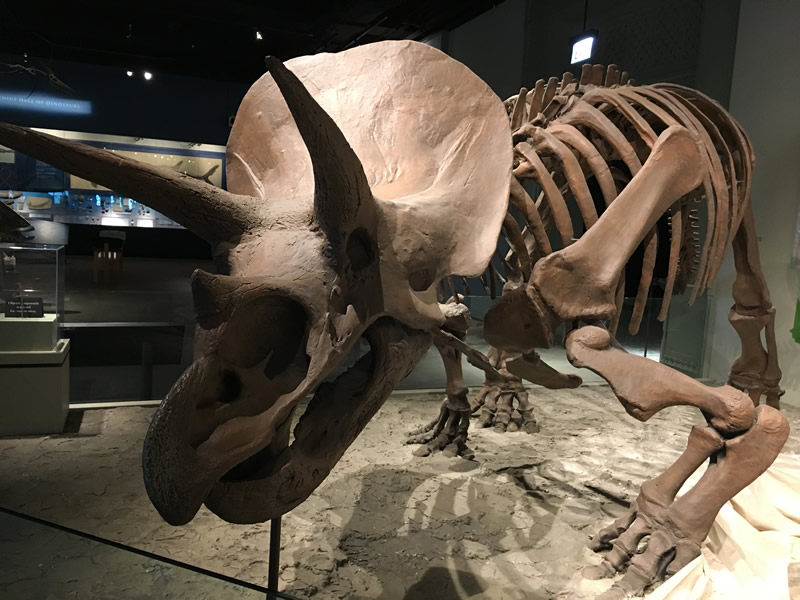South Dakota
Type |
Symbol |
Year Est. |
|---|---|---|
State Mineral Stone |
Rose Quartz |
1966 |
State Gemstone |
Fairburn Agate |
1966 |
State Fossil |
Triceratops |
1988 |
State Jewelry |
Black Hills Gold |
1988 |
State Mineral Stone: Rose Quartz
Rose Quartz is the pink variety of quartz, which is one of the most common minerals on Earth, primarily due to its simple structure and chemical formula, SiO2. Quartz also has an extremely high hardness, 7 on Mohs hardness scale, meaning that it doesn't scratch very easily and therefore does not break down easily. As the rocks on Earth are slowly eroded over time, most of the other minerals will break down into clay while quartz grains will generally just gets smaller and smaller. The result is that most beach sand is composed of quartz that has a slight hematite (rust) stain to it to give the sand grains their slight yellowish color. Although quartz is a simple mineral, it can come in a variety of colors depending on what type of impurities are present in the crystal structure; pure quartz crystal is clear, milky quartz is white, smoky quartz is grey, amethyst is purple quartz, citrine is yellow quartz, rose quartz is pink, as well as some other colors and varieties. Quartz does not have any cleavage, meaning that when it breaks it doesn't form along perfect surfaces. Instead as the quartz crystals grow, individual mineral molecules of quartz are added to the outside of the crystal from water rich in dissolved SiO2 or mineral melt (liquid rock like lava or magma).
Related: Alabama State Gemstone - Star Blue Quartz; Arkansas State Mineral - Quartz Crystal; Georgia State Gemstone - Quartz; New Hampshire State Gem - Smokey Quartz; South Carolina State Gem Stone - Amethyst
State Gemstone: Fairburn Agate
State Fossil: Triceratops

Triceratops horridus skeleton and cast from the Field Museum in Chicago, IL.
The first discovery of material attributed to Triceratops, was in 1887 by George Lyman Cannon near Denver, Colorado, who had found a set of the brow horns attached to a skull roof. He sent the material to O.C. Marsh who, assuming the rock dates were Pliocene, determined that it was from a prehistoric bison, which he named Bison alticornis. However after a more complete specimen was discovered in 1888 from Wyoming's Lance Formation by John Bell Hatcher, as well as a couple of other discoveries, Marsh reevaluated the initial find and eventually added all the finds under a new species, Triceratops, which he named in 1889, meaning "three-horned face".
Ceratopsian wall at the Natural History Museum of Utah. Triceratops is the one located in the far right at the top.
Triceratops belongs to a group of animals known as ceratopsians. Ceratopsians were prolific during the Cretaceous, with many different varieties evolving with various numbers of horns and frill adornments. Triceratops was one of the last ceratopsians to have evolved with remains having been found in rocks dating from ~69 million years ago to the end of the dinosaurs ~66 million years ago. It is estimated that Triceratops could grow up to 30 feet in length and weigh 12,000-16,000 pounds. There are currently two recognized species of Triceratops, T. horridus (pictured above in Chicago) and T. prorsus. The skull of Triceratops is one of the largest skulls ever discovered, approaching 10 feet in length in some individuals and not only had the three primary horns (one above each eye and one on the snout), it also had a series of spikes along the edge of the frill known as epoccipitals, and hornlike projects on the jugals (cheekbones). The horns are thought to serve multiple functions, such as defense from predators as well mating display structures.
Related: Wyoming State Dinosaur - Triceratops
State Jewelry: Black Hills Gold
The chemical symbol for gold is Au, and gold is one of the unique minerals that, in its pure form, is composed entirely of one element. It has a hardness of 2.5 to 3 on the Mohs hardness scale meaning that it actually is very soft (your fingernail is 2.5). For this reason most gold jewelry is mixed with another metal to prevent scratching and bending easily. The karat rating of the gold represents it's purity, where 24 karat is 99.9% pure, 22 karat 91.7%, 18 karat 75%, and so on. Gold naturally does not corrode or tarnish, so even when it is mixed with other metals it usually has a resistance to tarnishing, enhancing its value for jewelry. When gold is found in place, the highest grade of gold is often found in association with quartz veins. Currently gold is considered one of the most valuable metals on Earth, being used as the standard for most money (gold standard). Gold is often formed initially in relation to volcanic regions, where fluids associated with volcanoes carry the heavy metals up towards the surface and deposit them in rocks. These are found in areas of current or former subduction zones, places where two plates came together forcing one place down and melting it, while the other plate is forced upwards into mountains. Afterwards, erosion will take the gold out of the mountains and carry them down stream. However, since gold is so dense it does not travel easily down rivers and will often settle to the bottom of the river within the rocks and mud within the river sediment. These gold deposits are known as placer deposits and are the primary place where gold panners find gold. They can then use the locations of these placer deposits to backtrack to the original sources of the gold within the streams.
Related: Alaska State Mineral - Gold; California State Mineral - Gold; North Carolina State Mineral - Gold
References
https://statesymbolsusa.org/states/united-states/south-dakota
https://ninkasibrewing.com/
https://www.gbif.org/species/113684498
https://www.britannica.com/animal/Triceratops
Geology of South Dakota's National Parks
Through Pictures
(at least the one's I have been to)
Mount Rushmore National Memorial
Visited in 1997
Mount Rushmore National Memorial
Visited in 1997


